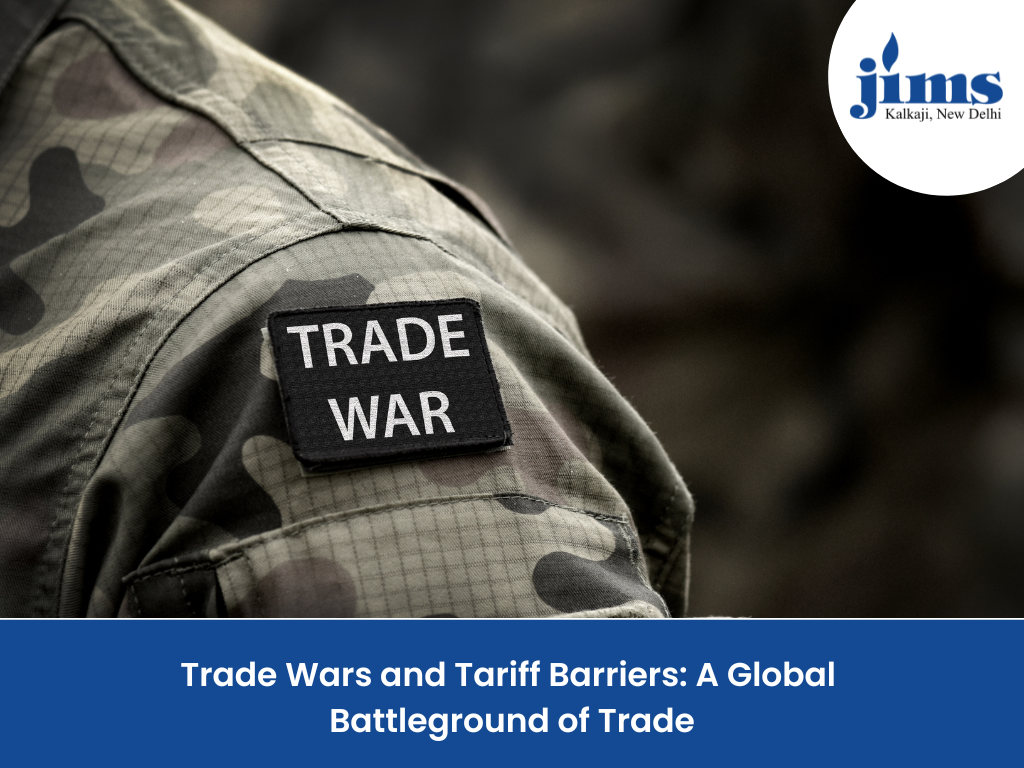
BY MS. SAKSHI SINGH
ASSISTANT PROFESSOR
JIMS KALKAJI (UG DEPARTMENT)
In a time of swift globalization and mutual reliance, trade has become a vital engine of economic expansion and global collaboration. However, in spite of the free trade ideal, disputes occur. A significant outcome of these clashes is the trade war, frequently driven by the tactical application of tariff barriers.
For students in Top business schools like JIMS Kalkaji, comprehending the mechanics, motivations, and consequences of these tools is crucial—not only from an economic viewpoint but also from strategic, political, and managerial standpoints
What is TRADE WAR?
A trade war is an economic dispute in which nations apply tariffs or other trade restrictions on one another in response to perceived inequitable trade practices. These activities hinder the normal course of commerce and are frequently based on protectionism, nationalism, or attempts to exert geopolitical dominance.
A trade conflict occurs when nations respond to one another by enforcing tariffs or additional trade barriers. These conflicts typically arise when one nation suspects another of participating in unfair trade activities — like flooding their market with low-cost goods or altering currency values — prompting them to increase tariffs on incoming products. The opposing nation usually responds similarly, intensifying the dispute.
Trade wars are usually not standalone occurrences; they unfold in cycles of retaliation, fostering a hostile atmosphere for international trade. In contrast to conventional wars conducted with military forces, trade wars occur through regulations and pricing strategies—however, their economic impacts can be just as harmful
The outcome? A tit-for-tat response of economic strikes that can damage businesses, consumers, and whole economies
Comprehending Tariff Barriers
A tariff is a tax imposed by a government on goods that are imported. When tariffs are enacted to limit foreign competition and safeguard local businesses, they transform into tariff barriers. Although these obstacles produce government income and can protect local employment temporarily, they also disrupt market dynamics.
Categories of Tariffs:
Ad Valorem Tariffs: A proportion of the item’s worth (for instance, 15% of the import cost).
Specific Tariffs: A set charge for each unit of the imported item (e.g., $100 for every ton of steel).
Composite Tariffs: A mixture of ad valorem and specific tariffs.
Tariff barriers are typically the initial measures used in a trade war, initiating a retaliatory cycle that can rapidly intensify. Governments implement tariffs and strategies for trade wars for different motives, frequently presented as attempts to rectify perceived imbalances in trade ties. Main driving forces consist of:
- Safeguarding Local Industries, particularly emerging industries that require time to gain competitiveness.
- Minimizing Trade Deficits By limiting imports and encouraging consumption within the country.
- Retaliation In response to perceived unfair actions such as dumping or subsidies.
- Job Protection and Safeguarding jobs in essential industries like manufacturing or agriculture.
For example, the U.S.–China trade conflict stemmed partly from worries about intellectual property theft, limitations on market access, and a significant trade disparity.
Let us Discuss the Economic and Strategic Effects of Global Tariff Wars
Trade conflicts and tariffs affect economies in intricate ways:
1. Rising Expenses for Consumers:
Tariffs increase the costs of imported products, which businesses frequently transfer to buyers. This inflationary strain can diminish purchasing power and alter demand trends
2. Disruption in the Global Supply Chain
In a globalized world, very few goods are produced wholly in a single country. Tariffs interrupt complex supply chains, compelling companies to reconsider their sourcing approaches and manufacturing sites. For business school students, this directly affects operations and logistics management.
3. Market Fluctuations and Ambiguity
Trade conflicts can undermine investor trust, disrupt currency markets, and influence stock values. Strategic planning is challenging in an unstable policy environment, influencing corporate investment choices.
4. Retaliation and Global Spillover
Trade wars rarely remain bilateral. Countries not initially involved may suffer collateral damage, especially those embedded in affected value chains. Multinational corporations must anticipate and adapt to these second-order effects.
5. Sustained Innovation Threats
Although protectionist measures might offer short-term defense for domestic industries, they can diminish motivation to innovate and maintain global competitiveness over time.
In Conclusion
- Given the recent U.S. trade policies and the revival of protectionism, it is clear that the global economic framework is experiencing a significant change. The belief that free trade inherently results in shared prosperity is being questioned by the increasing application of tariffs as instruments for strategic advantage.
- For students of business, this entails reconsidering the conventional structures of international business and supply chain management. The distinctions among economics, politics, and national security are becoming more indistinct, and thriving in this context will necessitate a multidisciplinary strategy—integrating financial acumen with geopolitical awareness, ethical guidance, and operational flexibility. The skill to manage tariffs, foresee policy changes, and create robust, flexible business models is now an essential requirement, not just a specialized ability.
- In a world shaped by global tensions and economic nationalism, trade wars and tariff barriers are not going away. In JIMS Kalkaji PGDM programme, the focus is on critically analysing these concepts—not just for passing exams, but for becoming efficient world class leaders and strategic managers in real-world organizations. By mastering the interplay between policy and profit, you’ll be better equipped to lead with clarity, resilience, and foresight in uncertain times.
- Business is no longer just about product, price, and promotion. It’s about navigating policy, interpreting global trends, and building strategies resilient to international shocks. By mastering the dynamics of trade wars and tariff barriers, tomorrow’s managers can become the agile, informed leaders the global economy needs.

